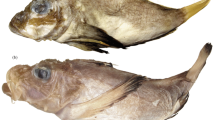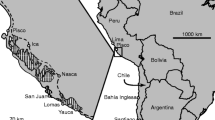Abstract—Morphological features of the byssal groove of the foot have been studied in the common mytilid species Mytilus coruscus, Crenomytilus grayanus and Modiolus modiolus from the Sea of Japan. A comparative analysis has shown interspecies differences in the length, width, and depth of the byssal groove and in the specificity of its structure, as well as in the size and shape of the distal fossa, where the byssal thread and the attachment disk are formed. The characteristics found in the morphological structure of the byssi in Myt. coruscus, C. grayanus, and Mod. modiolus are explained by the structural differences in their secretory organ.



Similar content being viewed by others
REFERENCES
Allen, J.A., Cook, M., Jackson, D.J., et al., Observations on the rate of production and mechanical properties of the byssus threads of Mytilus edulis L., J. Mollusc. Stud., 1976, vol. 42, no. 2, pp. 279–289.
Bairati, A. and Vitellaro-Zuccarello, L., The ultrastructure of the byssal apparatus of Mytilus galloprovincialis. II. Observations by microdissection and scanning electron microscopy, Mar. Biol., 1974, vol. 28, pp. 145–158.
Berger, V.Ya., Letunov, V.N., Vshevtsov, G.V., and Saranchova, O.L., Morphofunctional and ecological aspects of byssus formation in the mussel (Mytilus edulis L.), in Ekologiya obrastaniya v Belom more (Ecology of Fouling in the White Sea), Leningrad: Zool. Inst. Akad. Nauk SSSR, 1985, pp. 67–75.
Brown, C.H., Some structural proteins of Mytilus edulis, Quart. J. Microsc. Sci., 1952, vol. 93, pp. 487–502.
Carter, J.G., Harries, P.J., Malchus, N., Sartori, A.F., Anderson, L.C., Bieler, R., Bogan, A.E., Coan, E.V., Cope, J.C.W., Cragg, S.M., Cartἰa-March, J.R., Hylleberg, J., Kelley, P., Kleemann, K., Kříž, J., McRoberts, C., Mikkelsen, P.M., Pojeta, J., Jr., Tëmkin, I., Yancey, T., and Zieritz, A., Illustrated Glossary of the Bivalvia, Treatise online, 2012, vol. 1, no. 48, p. 15.
Denny, M.W., Lift as a mechanism of patch initiation in mussel beds, J. Exp. Mar. Biol. Ecol., 1987, vol. 113, pp. 231–245.
Denny, M., Gaylord, B., Helmuth, B., and Daniel, T., The menace of momentum: dynamic forces of flexible organisms, Limnol. Oceanogr., 1998, vol. 43, no. 5, pp. 955–968.
Eckroat, L.R. and Steel, L.M., Comparative morphology of the byssi of Dreissena polymorpha and Mytilus edulis, Am. Malacol. Bull., 1993, vol. 10, pp. 103–108.
Lukin, V.I. and Fadeev, V.I., Peculiarities of planning hydrobiological works in large water areas, in Podvodnye gidrobiologicheskie issledovaniya (Underwater Hydrobiological Research), Vladivostok: DVNTs AN SSSR, 1982, pp. 13–20.
Lutaenko, K.A. and Noseworthy, R.G., Catalogue of the Living Bivalvia of the Continental Coast of the Sea of Japan (East Sea), Vladivostok: Dalnauka, 2012.
Mironov, A.A., Komissarchik, Ya.Yu., and Mironov, V.A., Metody elektronnoi mikroskopii v biologii i meditsine: metodicheskoe rukovodstvo (Methods of Electron Microscopy in Biology and Medicine: A Methodological Guide), St. Petersburg: Nauka, 1994.
Price, H.A., Structure and formation of the byssus complex in Mytilus (Mollusca, Bivalvia), J. Mollusc. Stud., 1983, vol. 49, no. 1, pp. 9–17.
Pujol, J.P., Le complex byssogéne des mollusques bivalves: Histochimie comparee des secretions chez Mytilus edulis et Pinna nobilis, Bull. Soc. Lenn. Normand., 1967, vol. 10, pp. 308–332.
Skarlato, O.A., Dvustvorchatye mollyuski umerennykh shirot zapadnoi chasti Tikhogo okeana (Bivalves of Temperate Latitudes of the Western Part of the Pacific Ocean), Leningrad: Nauka, 1981.
Skarlato, O.A., Golikov, A.N., Vasilenko, S.V., et al., Composition, structure, and distribution of benthic biocenoses in the coastal waters of the Posyet Bay (Sea of Japan), Issled. Fauny Morei, 1967, vol. 5, no. 13, pp. 5–61.
Tamarin, A., An ultrastructural study of byssus stem formation in Mytilus califomianus, J. Morphol., 1975, vol. 145, pp. 151–178.
Tamarin, A. and Keller, P.J., An ultrastructural study of the byssal thread forming system in Mytilus, J. Ultrastruct. Res., 1972, vol. 40, pp. 401–416.
Vekhova, E.E., Reattachment of certain species of mytilid bivalves to various substrates, Russ. J. Mar. Biol., 2006, vol. 32, no. 5, pp. 308–311.
Vekhova, E.E., Comparative morphology of byssal filaments of three representatives of the family Mytilidae (Bivalvia) from the Sea of Japan, Zool. Zh., 2007, vol. 86, no. 2, pp. 154‒162.
Vekhova, E.E., Growth and shell morphology of three Mytilidae (Bivalvia) species from the Sea of Japan Biol. Bull. (Moscow), 2013, vol. 40, no. 9, pp. 728–737.
Vekhova, E.E., The adaptive morphology of byssus in Mytilus coruscus, Crenomytilus grayanus, and Modiolus modiolus (Mytilidae, Bivalvia) from the Sea of Japan, Biol. Bull. (Moscow), 2019, vol. 46, no. 9, pp. 1030–1044.
Vekhova, E.E., The byssal apparatus in the Pacific mussel, Mytilus trossulus (Bivalvia, Mytilidae), from the Sea of Japan, Biol. Bull. (Moscow), 2021, vol. 48, no. 9, pp. 1443–1451.
Waite, J., Adhesion in byssally attached bivalves, Biol. Rev. Cambr. Phil. Soc., 1983, vol. 58, no. 2, pp. 209–231.
Waite, J.H., Marine bioadhesion: unraveling the chemistry, J. Adhes. Soc. Jpn., 1997, vol. 33, no. 5, pp. 186–194.
Yonge, C.M., On the primitive significance of the byssus in the Bivalvia and its effects in evolution, J. Mar. Biol. Assoc. U.K., 1962, vol. 42, no. 1, pp. 113–125.
Zolotarev, V.N., Sklerokhronologiya morskikh dvustvorchatykh mollyuskov (Sclerochronology of Marine Bivalves), Kiev: Naukova dumka, 1989.
NOTATION
Abbreviations for Figs. 1–3: bg—byssal groove of the foot; vf—ventral surface of the foot; b—bottom of the byssal groove; de—distal end; df—distal fossa; f—foot of the mussel; d—ducts of glands; c—cilia of the byssal groove; fl— folds of the byssal groove; clf—closed folds of the byssal groove of the foot; p—papilla of the byssal groove of the foot.
ACKNOWLEDGMENTS
The author expresses her sincere gratitude to D.V. Fomin (Center for Collective Use of A.V. Zhirmunsky National Scientific Center of Marine Biology, Russian Academy of Sciences, Far Eastern Branch) for the assistance in the use of a Carl Zeiss, Sigma 300 VP scanning electron microscope.
Funding
The study was supported by the Russian Science Support Foundation. The study was supported by the Malacological Society of London.
Author information
Authors and Affiliations
Corresponding author
Ethics declarations
Conflict of interest. The author declares that she has no conflicts of interest.
Statement on the welfare of animals. All applicable international, national, and/or institutional guidelines for the care and use of animals were followed.
Additional information
Translated by N. Tarasyuk
Rights and permissions
About this article
Cite this article
Vekhova, E.E. The Comparative Morphology of the Byssal Groove of the Foot in Three Mytilid Species (Bivalvia, Mytilidae) from the Sea of Japan. Biol Bull Russ Acad Sci 49, 1562–1569 (2022). https://doi.org/10.1134/S1062359022090357
Received:
Revised:
Accepted:
Published:
Issue Date:
DOI: https://doi.org/10.1134/S1062359022090357




